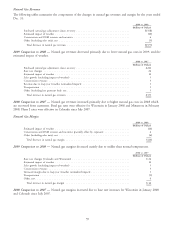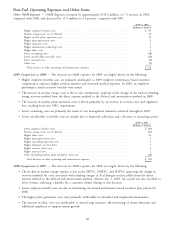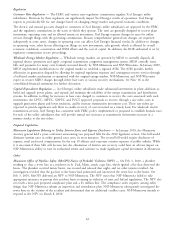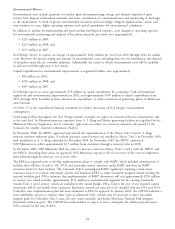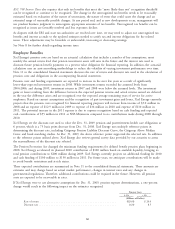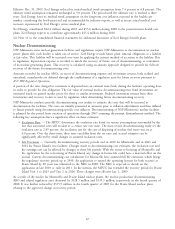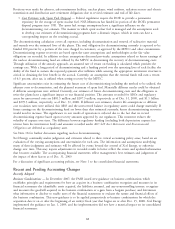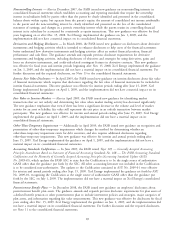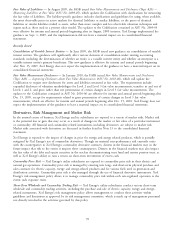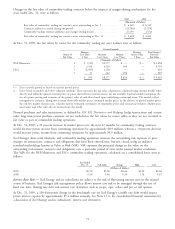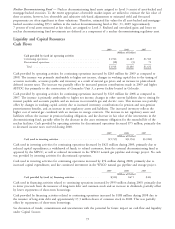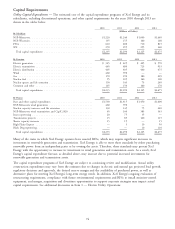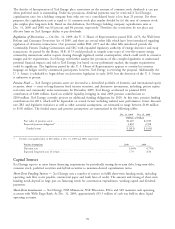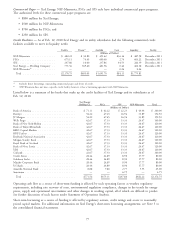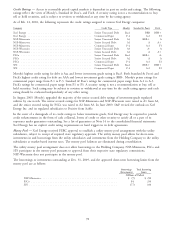Xcel Energy 2009 Annual Report Download - page 78
Download and view the complete annual report
Please find page 78 of the 2009 Xcel Energy annual report below. You can navigate through the pages in the report by either clicking on the pages listed below, or by using the keyword search tool below to find specific information within the annual report.
Revisions were made for asbestos, ash-containment facilities, nuclear plants, wind turbines, radiation sources and electric
transmission and distribution asset retirement obligations due to revised estimates and end of life dates.
• Cost Estimate with Spent Fuel Disposal — Federal regulations require the DOE to provide a permanent
repository for the storage of spent nuclear fuel. NSP-Minnesota has funded its portion of the DOE’s permanent
disposal program since 1981. The spent fuel storage assumptions have a significant influence on the
decommissioning cost estimate. The manner in which spent nuclear fuel is managed and the assumptions used
to develop cost estimates of decommissioning programs have a dramatic impact, which in turn can have a
corresponding impact on the resulting accrual.
The decommissioning calculation covers all expenses, including decontamination and removal of radioactive material,
and extends over the estimated lives of the plants. The total obligation for decommissioning currently is expected to be
funded 100 percent by a portion of the rates charged to customers, as approved by the MPUC and other commissions.
Decommissioning expense recoveries are based upon the same assumptions and methodologies as the fair value
obligations are recorded. In addition to these assumptions discussed previously, assumptions related to future earnings of
the nuclear decommissioning fund are utilized by the MPUC in determining the recovery of decommissioning costs.
Through utilization of the annuity approach, an assumed rate of return on funding is calculated which provides the
earnings rate. With a long period of decommissioning and a funding period over the operating lives of each facility, the
ability of the fund to sustain the required payments after inflation while assuring the appropriate investment structure is
critical in obtaining the best benefit in the accrual. Currently, an assumption that the external funds will earn a return
of 6.3 percent, after tax, is utilized when setting recovery by the MPUC.
Significant uncertainties exist in estimating the future cost of decommissioning including the method to be utilized, the
ultimate costs to decommission, and the planned treatment of spent fuel. Materially different results could be obtained
if different assumptions were utilized. Currently, our estimates of future decommissioning costs and the obligation to
retire the plants have a significant impact to our financial position. The amounts recorded for AROs and regulatory
assets for unrecovered costs are $881.5 million and $207.3 million, respectively, as of Dec. 31, 2009, and $1.1 billion
and $299.3 million, respectively, as of Dec. 31, 2008. If different cost estimates, shorter life assumptions or different
cost escalation rates were utilized, this ARO and the unrecovered balance in regulatory assets could change materially. If
future earnings on the decommissioning fund are lower than that estimated currently, future decommissioning recoveries
would need to increase. The significance to our results of operations is reduced due to the fact that we record
decommissioning expense based upon recovery amounts approved by our regulators. This treatment reduces the
volatility of expense over time. The difference between regulatory funding (including both depreciation expense less
returns from the investments fund) and amounts recorded under ASC 410 Asset Retirement and Environmental
Obligations are deferred as a regulatory asset.
See Note 18 for further discussion regarding nuclear decommissioning.
Xcel Energy continually makes judgments and estimates related to these critical accounting policy areas, based on an
evaluation of the varying assumptions and uncertainties for each area. The information and assumptions underlying
many of these judgments and estimates will be affected by events beyond the control of Xcel Energy, or otherwise
change over time. This may require adjustments to recorded results to better reflect the events and updated information
that becomes available. The accompanying financial statements reflect management’s best estimates and judgments of
the impact of these factors as of Dec. 31, 2009.
For a discussion of significant accounting policies, see Note 1 to the consolidated financial statements.
Recent and Pending Accounting Changes
Recently Adopted
Business Combinations — In December 2007, the FASB issued new guidance on business combinations which
establishes principles and requirements for how an acquirer in a business combination recognizes and measures in its
financial statements the identifiable assets acquired, the liabilities assumed, and any noncontrolling interest; recognizes
and measures the goodwill acquired in the business combination or a gain from a bargain purchase; and determines
what information to disclose to enable users of the financial statements to evaluate the nature and financial effects of
the business combination. This new guidance is to be applied prospectively to business combinations for which the
acquisition date is on or after the beginning of an entity’s fiscal year that begins on or after Dec. 15, 2008. Xcel Energy
implemented the guidance on Jan. 1, 2009, and the implementation did not have a material impact on its consolidated
financial statements.
68



